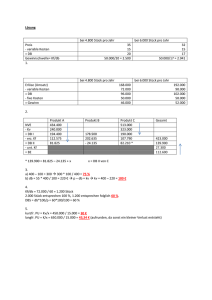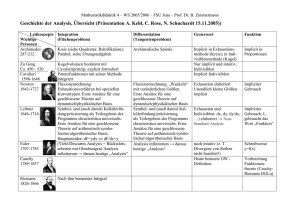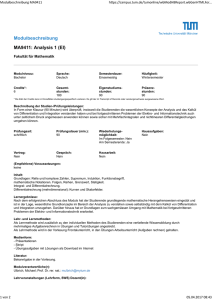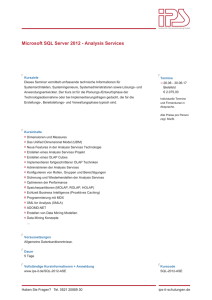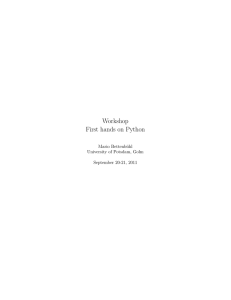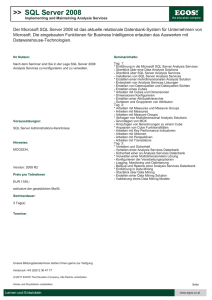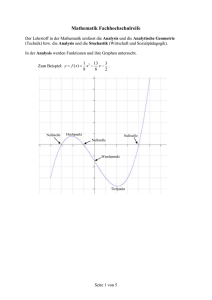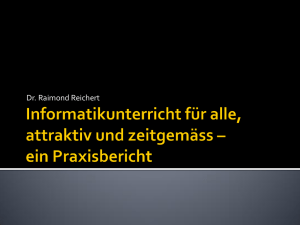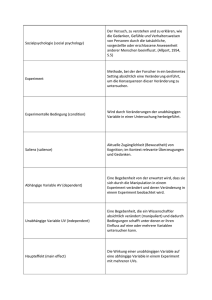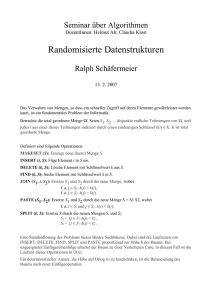Exercise 1, Due date 25.04.2008
Werbung
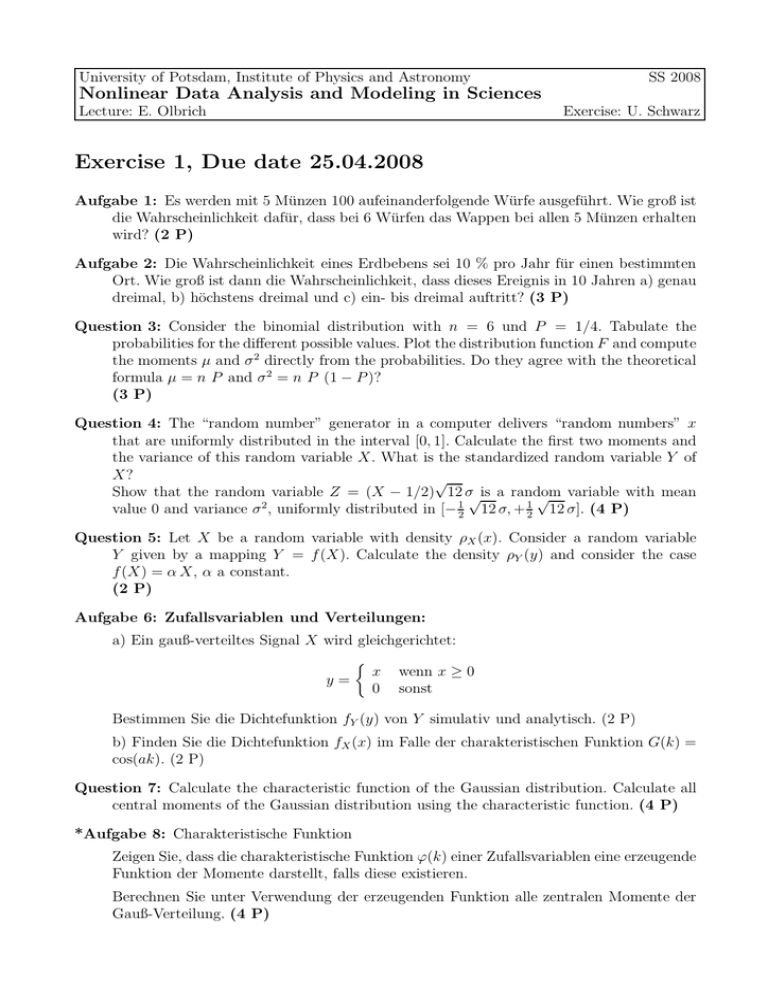
University of Potsdam, Institute of Physics and Astronomy SS 2008 Nonlinear Data Analysis and Modeling in Sciences Lecture: E. Olbrich Exercise: U. Schwarz Exercise 1, Due date 25.04.2008 Aufgabe 1: Es werden mit 5 Münzen 100 aufeinanderfolgende Würfe ausgeführt. Wie groß ist die Wahrscheinlichkeit dafür, dass bei 6 Würfen das Wappen bei allen 5 Münzen erhalten wird? (2 P) Aufgabe 2: Die Wahrscheinlichkeit eines Erdbebens sei 10 % pro Jahr für einen bestimmten Ort. Wie groß ist dann die Wahrscheinlichkeit, dass dieses Ereignis in 10 Jahren a) genau dreimal, b) höchstens dreimal und c) ein- bis dreimal auftritt? (3 P) Question 3: Consider the binomial distribution with n = 6 und P = 1/4. Tabulate the probabilities for the different possible values. Plot the distribution function F and compute the moments µ and σ 2 directly from the probabilities. Do they agree with the theoretical formula µ = n P and σ 2 = n P (1 − P )? (3 P) Question 4: The “random number” generator in a computer delivers “random numbers” x that are uniformly distributed in the interval [0, 1]. Calculate the first two moments and the variance of this random variable X. What is the standardized random variable Y of X? √ Show that the random variable Z = (X − 1/2) 12 σ√is a random √ variable with mean value 0 and variance σ 2 , uniformly distributed in [− 12 12 σ, + 21 12 σ]. (4 P) Question 5: Let X be a random variable with density ρX (x). Consider a random variable Y given by a mapping Y = f (X). Calculate the density ρY (y) and consider the case f (X) = α X, α a constant. (2 P) Aufgabe 6: Zufallsvariablen und Verteilungen: a) Ein gauß-verteiltes Signal X wird gleichgerichtet: x wenn x ≥ 0 y= 0 sonst Bestimmen Sie die Dichtefunktion fY (y) von Y simulativ und analytisch. (2 P) b) Finden Sie die Dichtefunktion fX (x) im Falle der charakteristischen Funktion G(k) = cos(ak). (2 P) Question 7: Calculate the characteristic function of the Gaussian distribution. Calculate all central moments of the Gaussian distribution using the characteristic function. (4 P) *Aufgabe 8: Charakteristische Funktion Zeigen Sie, dass die charakteristische Funktion ϕ(k) einer Zufallsvariablen eine erzeugende Funktion der Momente darstellt, falls diese existieren. Berechnen Sie unter Verwendung der erzeugenden Funktion alle zentralen Momente der Gauß-Verteilung. (4 P) *Aufgabe 9: Kumulanten Beweisen Sie die Beziehung ln ϕ(k) = ∞ X (ik)n n=1 n! κn (1) mit den Kumulanten κ1 = m1 , κ2 = m2 − m21 = µ2 , κ3 = m3 − 3m1 m2 + 2m31 = µ3 , κ4 = µ4 − 3µ22 , . . . (4 P) Aufgabe 10: Erläutern Sie die Idee von Hypothesentests im Sinne der Statistik. Was bedeuten die Begriffe: positiver Test, Prüfgröße, Prüfparameter, kritischer Wert, Irrtumswahrscheinlichkeit, Fehler 1. und 2. Art. (4 P) Aufgabe 11: Hypothesentest Prüfen Sie die Alternativhypothese µ1 6= µ2 auf den Signifikanzniveaus von 1 und 5 %: n1 = 29, m1 = 43.7, s21 = 31.44, n2 = 31, m2 = 40.2, s22 = 24.55. ni , mi und si bezeichnen die Stichprobenumfänge, die geschätzten Mittelwerte und geschätzten Varianzen. Ist die Gleichheit der Varianzen gegeben? (2 P) Aufgabe 12: Homogenitätstest, χ2 -Unabhängigkeitstest, Kontingenztest Gliedert man 100 Sterne einer Stichprobe nach zwei Merkmalen, so findet man, dass 33 kühle Sterne ein Magnetfeld haben und 20 nicht. Von den heißen Sternen sind 9 magnetisch und 38 nicht. Sind die Merkmale bei einer Irrtumswahrscheinlichkeit von 5 % stochastisch abhängig? (2 P) http://personal-homepages.mis.mpg.de/olbrich/data_analysis.html Lectures: Eckehard Olbrich, N. Marwan, A. Bergner Fr 11:00-12:30 Building 28 Room 0.104 Exercises: Udo Schwarz Do 11:00-12:30 Building 28 Room 0.104 Computer lab: Udo Schwarz, Eckehard Olbrich Fr 13:30-15:00 Building 28 Room 0.087 Linear methods: * James D. Hamilton, Time series analysis, Princeton University Press, 1994 * M. B. Priestley, Spectral analysis and time series, 9. printing, London, Academic press, 1996 * Peter J. Brockwell and Richard A. Davis, Introduction to time series and forecasting, New York, Springer, 1996 * Peter J. Brockwell and Richard A. Davis, Time series : theory and methods, New York, Springer, 1991 Nonlinear time series analysis * H. Kantz and T. Schreiber, Nonlinear time series analysis, 2nd edition, New York, Cambridge University Press, 2004 * Henry D. Abarbanel, Analysis of Observed Chaotic Data, New York, Springer, 1997 Stochastic Systems * J. Honerkamp, Stochastic Dynamical Systems: Concepts, Numerical Methods, Data Analysis, Wiley & Sons, 1993
![fast alle [Analysis] alle bis auf endlich viele. Bsp. 1](http://s1.studylibde.com/store/data/005995244_1-947f17bb2bc600115487b7e2a9860c32-300x300.png)
